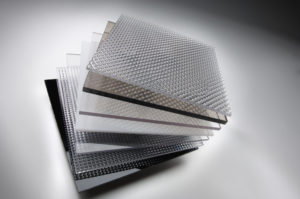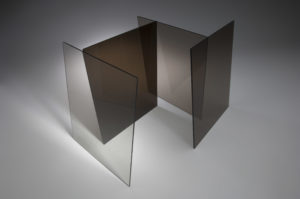Acrylic and polycarbonate are two of the most popular plastic materials across multiple industries. Both materials offer an array of benefits and work in many different applications, from vehicle operator protection to retail display cases. Both materials are hailed for their glass-like visibility, and their shatter-resistant properties, making both of them popular safety investments. They’re also lightweight and durable, providing economical and practical solutions in several industries.
Since both are widely utilized as see-through plastics, the two are often compared. Both materials serve as quality alternatives to glass. However, their similarities are accompanied by distinct differences that make them better suited for specific applications. Their end-uses are very similar, but choosing which is better for your specific application depends on your needs.
What is Acrylic?
Acrylic, also known as PMMA (or polymethyl methacrylate), is an amorphous plastic characterized by its transparency, non-toxicity, and strength. This lightweight material is commonly used as a shatter-resistant alternative to glass, offering up to 20 times the impact resistance at half the weight. It also features high UV resistance, making it incredibly useful in outdoor applications.
Polymershapes is a leading plastics supplier of acrylic throughout North America. Browse our acrylic options here.
Acrylic: Pros & Cons
Pros
- More transparent: Acrylic features a glossier, optically clear appearance compared to polycarbonate.
- Scratch resistance: Acrylic is typically more scratch resistant than polycarbonate. Scratches can be buffed out when they occur.
- Inherently UV resistant: Acrylic will not deteriorate due to UV exposure, making it a good option for outdoor applications.
- Color and polish options: Many different grades are available, including opaque and translucent colors, providing a wide array of design options. Acrylic can also undergo mechanical and flame polishing, unlike polycarbonate.
- Adhesive qualities: Glue and other adhesives stick better to acrylic.
Cons
- Stiffness: Cracks and breaks easier than polycarbonate when bent or warped.
- Lower strength and durability: Although more impact resistant than glass, acrylic is generally not as impact resistant as polycarbonate.
- Limited cleaning options: Certain aggressive cleaning agents could damage the material.
What is Polycarbonate?
Polycarbonate plastic, often branded as LEXAN™, is an amorphous thermoplastic known for being virtually unbreakable. Polycarbonate offers very similar optical qualities to glass, but is 250 times stronger and significantly lighter. Along with its incredible strength, polycarbonate sheets have a very wide operating temperature range, offering stable performance up to 265°F (130°C).
Polymershapes is a leading plastics distributor of LEXAN™ polycarbonate sheets. Visit us today to learn more.
Polycarbonate: Pros & Cons
Pros
- Virtually Unbreakable: Polycarbonate is 250x more impact resistant than glass.
- Cold bending: With lower rigidity than acrylic, this material can be bent without breaking or cracking, and won’t require thermoforming to do so.
- Chemical resistance: It is highly resistant to acids and chemicals, making it more suitable for certain applications.
- More cleaning options: Due to its chemical resistance, Polycarbonate can be cleaned with harsher cleaning agents.
- Low flammability: Low flammability means improved safety and resilience. FR grades are also available for increased flame resistance.
Cons
- Easier to scratch than acrylic: While polycarbonate is more durable, it may succumb to scratches more often. Scratches are also difficult to remove.
- Lower UV resistance: UV rays will cause polycarbonate to yellow over time. UV grades are available, but acrylic is inherently UV resistant.
- Slightly lower clarity: Polycarbonate is slightly less transparent than acrylic.
Frequently Asked Questions
What’s the Difference Between Acrylic and Polycarbonate?
Although both materials are amorphous plastics due to their chemical makeup, they have distinct differences. Polycarbonate is an amorphous standard plastic, whereas acrylic is an amorphous commodity material. Standard materials are classified higher than Commodity materials due to their wider temperature range. In turn, polycarbonate is stronger, more durable than acrylic. However, acrylic is a more economical option for applications where high-impact resistance isn’t necessary.
What’s the Difference Between LEXAN™ vs “Plexiglass”?
With a long list of material brand names, it may be hard to know which name is associated with either product. LEXAN™ and Plexiglass are both trade names for plastic sheet materials known as Polycarbonate and Acrylic.
LEXAN™, developed by SABIC, is one of the most reputable brands of polycarbonate.
“Plexiglass” is a common term for acrylic, but it actually refers to a specific brand of acrylic called Plexiglas®, developed by Trinseo. Other trade names for acrylic include OPTIX®, developed by Plaskolite, and Acrylite®, developed by Roehm.
Polymershapes proudly partners with the industry’s top manufacturers to offer the highest quality polycarbonate and acrylic sheets.
Which is Stronger: Acrylic or Polycarbonate?
While both materials are significantly stronger than glass, polycarbonate exceeds acrylic’s resistance to impact, which may crack or break when hit hard enough. Polycarbonate can withstand harsher rams and smashes without damage. Certain grades can even be made to resist damage from bullets.
When To Use Polycarbonate vs Acrylic
Both acrylic and polycarbonate are both clear plastics, meaning they may be used interchangeably. However, some applications may favor one over the other.
Acrylic is preferred when optical clarity or UV resistance is the primary need. Acrylic is often the go-to alternative to glass in outdoor applications. It provides glass-like clarity at a fraction of the weight. Specialty grades are also available for more specific needs such as light diffusion for signage, or enhanced impact resistance for high-traffic areas.
Polycarbonate is preferred for protection or security applications, or if the application requires exposure to high heat. Its strength and durability make it a lightweight safety feature in many applications. Specialty grades are also available to add or enhance other qualities, such as scratch or UV resistance.
Common Uses for Polycarbonate (LEXAN™)
Polycarbonate’s strength and durability makes it the go-to material for:
- Bullet resistant glazing, windows, and doors
- Windshields and operator protection (FOPS, ROPS, or OPS in construction vehicles, heavy duty machinery, etc.)
- Visors in protective sporting gear
- Technology cases
- Machinery guards
- Industrial protection and guards (especially in chemical facilities)
- Signage
Polycarbonate’s durability and clarity make it the go-to substitute for glass in applications where safety is paramount. Its durability makes it a great protective material that won’t impair the vision of machine operators or any individual that may be wearing a helmet. It can also be made into heavy-duty casings designed to protect sensitive materials.
Common Uses for Acrylic (Plexiglass)
Acrylic’s shatter resistance and optical quality make it the go-to replacement for glass in many applications, such as:
- Recreational vehicle windows (golf carts, ATVs, etc.)
- Sunroofs, skylights, and exterior windows
- Protective glazing
- Helmet visors
- Partitions
- Retail display cases
- Light fixtures and diffusing panels
- Transparent shelves and holders
Despite glass’s optical clarity, it can pose a major health and safety hazard if shattered. Acrylic is a useful alternative that can provide similar optical clarity with improved strength and protection. Even if the acrylic sheet manages to break, the pieces will be much larger, making shards easier to spot and easier to clean.
Which is More Scratch Resistant?
Generally speaking, polycarbonate is much easier to scratch than acrylic. Acrylic’s hardness makes it significantly more scratch resistant than polycarbonate. In many cases, scratches can even be buffed out of acrylic sheets.
Polymershapes Can Help You Decide: Acrylic versus Polycarbonate
For over 70 years, Polymershapes has proudly partnered with the world’s largest manufacturers of clear plastics and alternative materials to glass. From SABIC’s LEXAN™ polycarbonate to Plaskolite’s OPTIX® acrylic, our inventory is stocked with high-quality products.
Visit our branch locator to find a Polymershapes distribution center near you.

